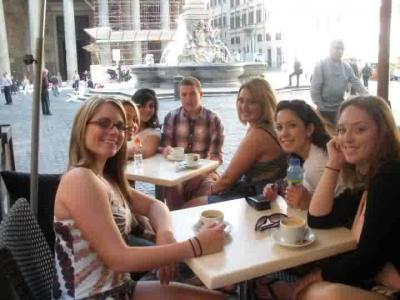NMSU students immerse themselves in Italian culture through HRTM program

Every day, she would walk passed the Duomo. On most days, she and her friends would stop for some pastries and cappuccino at a nearby café before continuing on to the school for a full day of lessons in Italian history, culture and cooking with fresh, local foods.
"Florence is such a small city and it has large buildings," said Campos. You would think that you would feel claustrophobic, but when you walk around and see the buildings, you are overtaken by the beauty of it, and it feels like you're floating; it doesn't seem real."
Campos spent three weeks this summer in Italy as part of a program in the College of Agricultural, Consumer and Environmental Sciences' School of Hotel, Restaurant and Tourism Management to give students the opportunity to immerse themselves in another culture.
"The goal of this program is to provide HRTM students an international educational experience," said Greg Blanch, an HRTM associate professor who organizes the trip every summer and also travels to Italy with the students to teach. "After they graduate, students find themselves increasingly in work world situations where they are interacting with people from all over the world, both people who are supervising them and those they will eventually supervise. Whatever we can do to help students broaden their educational experience, we find to be beneficial."
The program originated three years ago with a partnership with the University of New Mexico. UNM eventually dropped out, but NMSU chose to continue pursuing the goal of sending students to Italy.
The first group to travel to Italy consisted of 28 students, including Kyle McCracken, a graduate student in communications who was an undergraduate in HRTM at the time.
"Our days consisted of classes between Monday through Thursday at the Pantheon Institute, which I thought was absolutely amazing," said McCracken. "You're sitting at your desk learning hospitality, and you look out your window and there sits the Pantheon in full view. I thought it was an amazing experience."
McCracken said that along with attending daily classes at the institute, students were given tasks to perform outside of class, such as visiting a historical location or viewing a local food market.
"Everything is completely different from the U.S., from the everyday activity down to the most complex task," he said. "People wear different clothes. They act differently. I think that is probably one of the biggest things I learned while I was over there. It's just an eye-opening experience."
McCracken said he was drawn to participate in the program after Blanch discussed the trip in one of his classes. McCracken, a former math major, saw it as an opportunity to make up some credit hours he lost when he transferred to HRTM.
Students earn nine credit hours for attending the summer course. They hold fundraising events throughout the year to help offset the costs associated with the trip.
David Herring, who was part of the most recent 12-member group to travel to Italy, along with Campos, said their days were not just filled with learning the history of Italian foods and tasting wines. There were also occasions for planned outings as well as more spontaneous trips on their own.
Herring said some of the highlights from his time abroad include seeing the statue David, visiting area wineries and also traveling through the Tuscan countryside.
"This is a really good world experience to see other places and experience other cultures," Herring said. "I might go back. That is definitely a possibility."
One student who has definite plans to return after she graduates from NMSU is Campos, who fell in love with the cooking school and hopes to do graduate studies there learning Italian pastries.
Campos said what she has taken away from her journey to Italy is the vast difference in the types and quality of foods there.
"We tried a lot of things that I would never have thought eating together, like cheese with honey drizzled on it," she said. "Italian cheese has an intense flavor and honey calms it down and makes the cheese more enjoyable."
All the food is organic, Campos said, and grown locally and in season. Rather than use pesticides or other chemicals to deter pests, farmers in Italy plant rosebushes at each end of a line of produce, such as grapes at a winery. If the roses died, farmers knew they had pests to deal with. She said she and her roommates would buy fresh produce on a daily basis.
Campos, McCracken and Herring all said another adjustment they had to make in Italy is a practice known as the slow food movement. Whereas people in the U.S. are used to fast food and drive-through meals, it is not uncommon for Italians to take two to four hours to eat dinner with family and friends.
"They take the time to sit down and eat," Campos said. "They don't take food to go. They want you to sit down and enjoy your food. It's a bonding experience. That's part of the reason a lot of us got very close during that time because we all ate together."
The students said studying abroad has helped open their eyes to the world around them and given them an edge as they continue to pursue culinary careers.
"I think studying abroad would help anybody," McCracken said. "The economy is becoming so much more globalized. This program really opens your mind and makes you less narrow minded to the way the world works."


